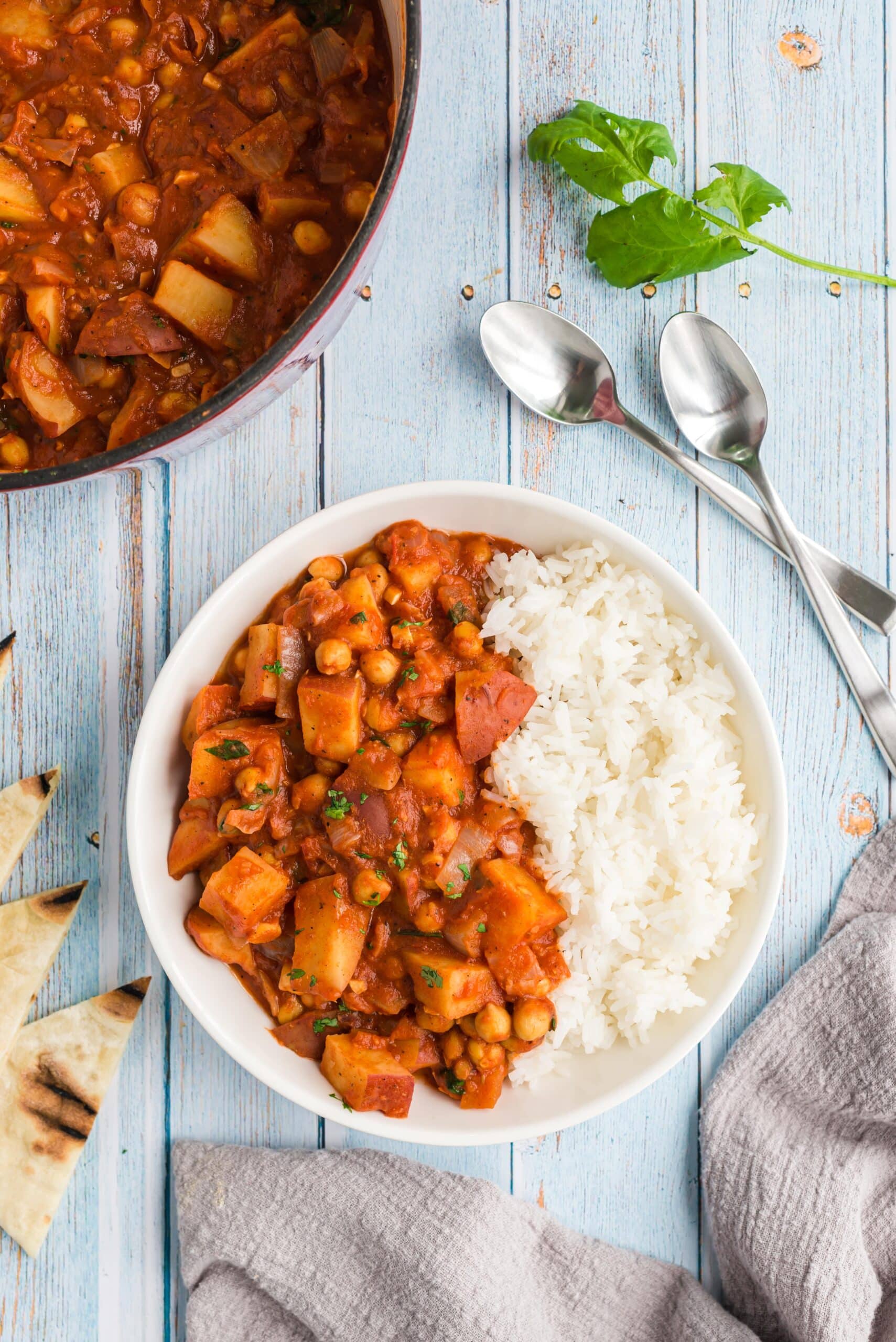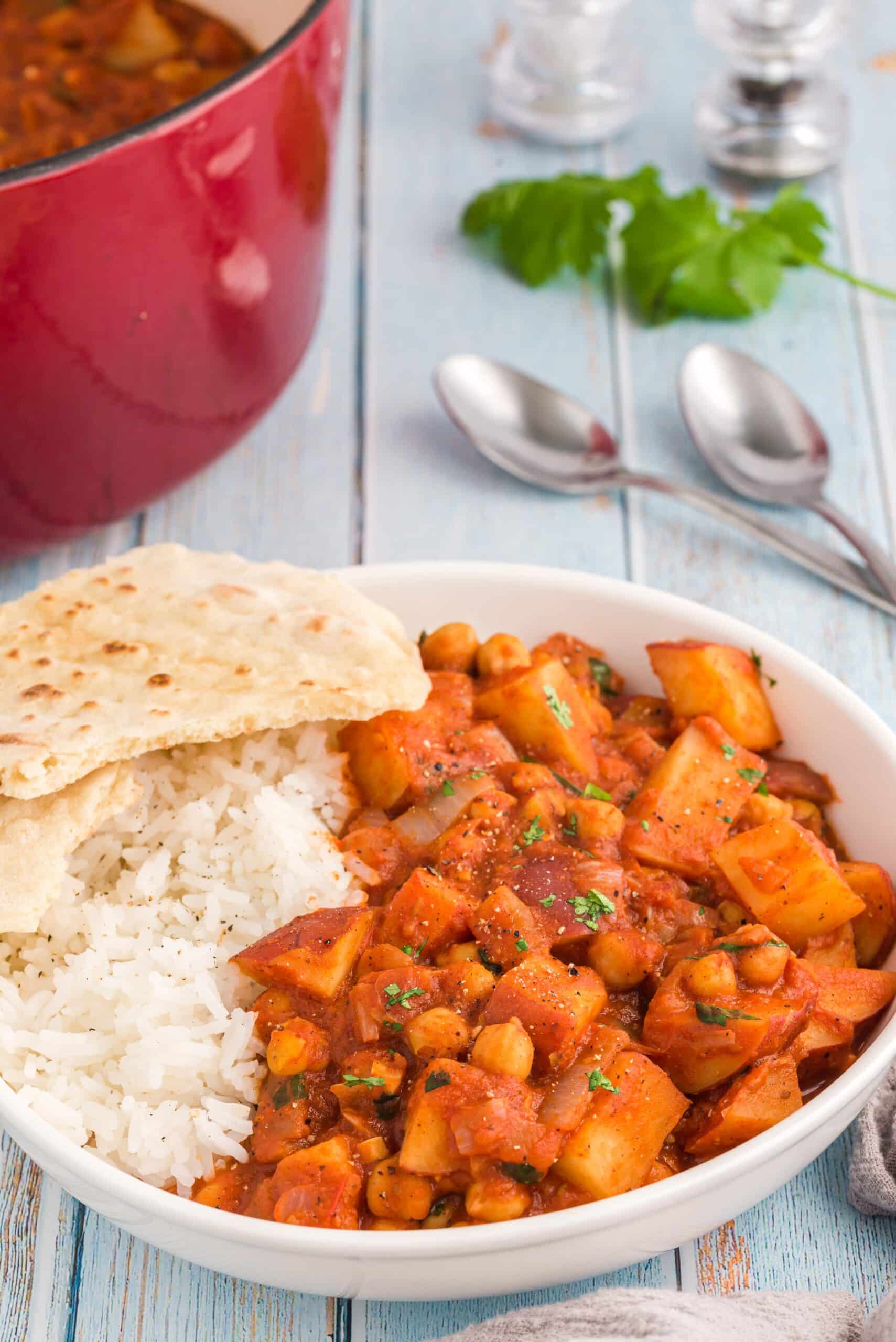Vegan Butter Chicken is a healthy, delicious version of Butter Chicken. This butter chicken recipe is meat-free, dairy-free, vegan, gluten-free, oil-free, and soy-free, with a nut-free option.
This no butter no chicken recipe is found in Dreena’s Kind Kitchen… has been a favorite with readers for years – read on!

This vegan butter chicken recipe came about quite a few years ago when I was speaking at a vegan festival (Ottawa VegFest). During some food chat with a volunteer (hi Natalie!) at the event, the topic of veganizing butter chicken came up.
As I’ve been vegan for so long, I’ve never tried butter chicken. But I do know how much people love the dish.

Chatting with Natalie, she mentioned she made a vegan butter chicken dish and I said “oh, I‘ve got to create a recipe when I get home“!
And I did.
I did a little research on the flavors and components of the dish and created my own ‘healthied’ up vegan butter chicken.

My “No Butter No Chicken” is abundantly flavorful – rich yet not heavy. You can always increase the cashew cream or coconut milk if you like. For me, the balance of flavor and richness is just right.
To save time, you might want to opt for the coconut milk version. However, I will say that the cashew cream version makes this plant-based butter chicken recipe especially delicious!
So if you have the time (and really, it doesn’t take that long) make the cashew cream! You can use the cashew cream recipe from this post – works a charm.

That’s it, let’s get to this vegan butter chicken, already! Let me know how you like it in the comments.
I’d love to hear how you serve it, and whether you opt for the cashew or coconut version.
Enjoy! x Dreena
Vegan Butter Chicken Recipe
Ingredients
- 2 cups chopped onion
- 3/4 cup coconut cream or cashew cream (see link in notes) use coconut cream for nut-free version: 1 small can (160 ml) regular coconut milk (remove 2-3 tbsp of coconut water to saute), see note
- 1 tbsp garam masala
- 1 tsp cumin seeds
- 1/2 tsp cinnamon
- 1 tsp ground coriander
- 1/4 tsp crushed red pepper flakes
- 1 – 1 /4 tsp salt
- black pepper to taste optional
- 3 cloves garlic minced
- 1 28 oz can crushed tomatoes
- 2 14 / 15 oz cans chickpeas rinsed/drained (about 3 1/2 cups)
- 5 cups cubed red or yellow potatoes not russet, see note (roughly 2 lbs)
- 1 tbsp grated fresh ginger see note
- 1/4 – 1/2 cup chopped fresh cilantro optional, use to taste
- lemon wedges for serving
Instructions
-
In a large pot over medium-high heat, add the onion, 2-3 tbsp coconut milk (see note), and the spices and salt. Saute, stirring occasionally, for 6-7 minutes. Add more of the coconut milk if needed, if mixture is sticking. After this time, add the garlic, and stir through for a minute. Add tomatoes, chickpeas, and potatoes. Turn heat to high, and bring mixture to a boil. Once it reaches a boil, reduce heat to low, cover, and let simmer covered for 25-30 minutes, until potatoes are fork tender. Add ginger, and remaining coconut milk or cashew cream (use as much as you like, or as little) and stir through. If using cilantro, add to taste and stir through long enough for it to wilt. Taste, add additional salt and pepper if desired. Serve with lemon wedges for serving.
Notes
- Serving Suggestions: Serve over cooked brown rice or other cooked grain. Try serving along with roti or other flatbreads, along with a sweet chutney.
- Coconut Milk Note: Use regular coconut milk. When you open the can, there will be a thicker cream portion, and a more milky water. Use a few tablespoons of the milky water to saute, then add the remaining cream to finish. If using cashew cream, simply saute in 2-3 tbsp of water. If you want a lower-fat version, use less cream, 1/2 cup or less.
- Potato Note: Use potatoes that will hold their shape after cooking. Red or yellow potatoes work better than russet. If you do use russet, just know they will likely break down more in the sauce.
- Ginger Note: I like adding the ginger at the end of cooking to keep it vibrant. You can add it earlier while sautéing the spices, if you prefer, or divide adding the ginger between the sauce and finishing.
This post was originally published February 2018 and has been updated for February 2024.



